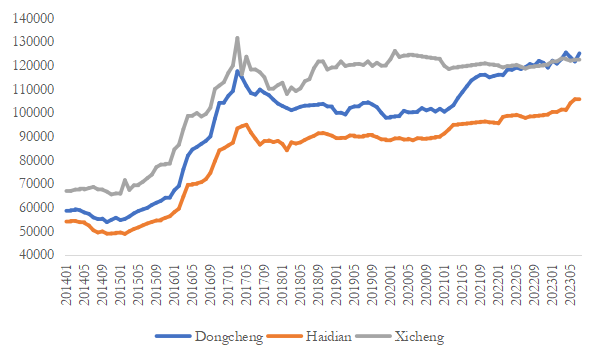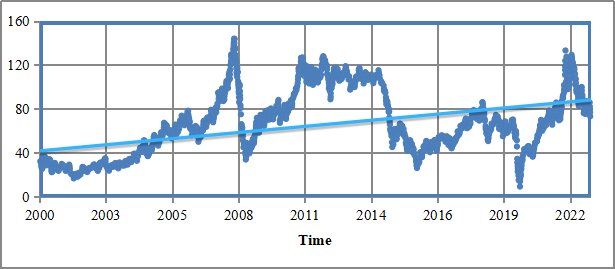

Volume 54
Published on December 2023Volume title: Proceedings of the 2nd International Conference on Financial Technology and Business Analysis

In China, school enrollment district segmentation changes often raise fluctuations of housing market. Once a house is segmented into a popular school district, its price will immediately skyrocket. To curb the hidden educational inequality caused by this phenomenon, many Chinese cities, including Beijing, are attempting to ‘cool down’ school district housing by adjusting existing school district segmentation. This paper aims to verify the impact of school district segmentation changes on housing prices in selected districts of Beijing. Through time-varying difference-in-difference method, this study found no significant correlation between the changes in school district segmentation and the fluctuation of housing prices in different administrative districts in Beijing. This study is significant for understanding the housing market situation in Beijing and the real-world effect of school district segmentation changes. Policy makers should take housing market prices into consideration when making school district policy decisions and make further researches to investigate the effects of new school district segmentation on neighborhood-level housing prices.

 View pdf
View pdf



The expectancy theory is a tool that is widely used by companies around the world. Through a well-established reward system, employees put more time and effort into their work, knowing that they will be rewarded for their efforts. However, Nsofor found that each employee is motivated in a different way. A large part of employees are not suitable for implementing the expectancy theory. Therefore, this paper focuses on the application and limitations of expectancy theory in organizations. This research found that expectancy theory is limited in scope, does not include other factors explaining motivation, and is only limited to material reward. Also, expectancy theory can only be applied to performance that can be easily measured. This research paper demonstrates the credibility of the above viewpoints through different case studies. This paper can also enhance cooperation’s understanding of expectancy theory.

 View pdf
View pdf


Public aviation transport plays a vital role in the comprehensive transportation system of a country. To ensure the healthy development of the public aviation transport industry, the government has implemented a series of subsidy policies. Evaluating the effectiveness of these subsidy policies is of significant importance for the economic and social development of regions and the improvement of people’s quality of life. This paper empirically analyzes the effects of subsidy policies on regional aviation routes using a multi-period Difference-in-Differences (DID) model based on data spanning from 2009 to 2019. The research indicates that subsidy policies have a positive feedback effect on the public aviation transport industry and are likely to continue producing favorable outcomes. However, there are regional variations in the responses to these policies. Furthermore, considering the current policy landscape and research findings, this paper offers recommendations for optimizing subsidy policies, providing valuable insights for policy decision-making.

 View pdf
View pdf


Behaviour finance gained more and more weight in the development of finance theory in comparison to standard finance theory which is dominated by the efficient market hypothesis. As a field of behavioural economics, it combines psychology and finance to understand how human behaviour and cognitive biases impact financial decision-making. Some market anomalies which seem strange or impossible according to standard finance theory can be understood and explained with the help of behavioural finance theory. Through analysis and literature review, this paper explores the common expressions of irrational behaviour such as representativeness, herd effect, anchoring, overconfidence, and their effect on the investment financial market. This paper finds that people can be easily influenced by any given information. Individuals’ personalities and social backgrounds also play a decisive role in making investment decisions. Therefore, some possibilities and advice to reduce the losses caused by human cognitive biases are also provided in the paper.

 View pdf
View pdf


A prominent American electric vehicle and renewable energy company, with a history of leadership and innovation in the automotive sector, Tesla has consistently pioneered advancements. This study explores Tesla’s synchronization of online and offline marketing tactics, and probes how Tesla’s dual marketing approaches, online and offline, complement each other through employing a case study method, which encompasses distinct brand positioning, emphasis on digital and regional strategies, active social media integration, seamless online-offline interplay, and varied advertising methods such as word-of-mouth and pricing techniques. Tesla’s robust collaborations within the supply chain further fortify its competitive standing. The findings sustain Tesla’s market leadership and hold broader implications. They contribute to heightened market competitiveness, shed light on marketing models for emerging markets, reveal the potential of digital marketing, and even inspire the transformation of traditional automotive business practices. Today, Tesla cars already occupy a very high market share. Compete in the market through several different strategic approaches. Now people need to study what kind of model and supply chain can make this brand popular and successfully pay for it.

 View pdf
View pdf


As an “infrastructure industry”, the pharmaceutical industry is related to people’s livelihood and social stability and is one of the pillar industries of society. With the in-depth advancement of various medical policy reforms since 2021, the scale of China’s pharmaceutical market has continued to rise, and the revenue and profit of the pharmaceutical industry have maintained steady growth, so the industry still has outstanding growth advantages. Based on the pharmaceutical industry, this paper selects Guangzhou Baiyunshan Pharmaceutical Group as the research object, takes the company’s financial data from 2018 to 2022 as the basis, conducts a comprehensive study on the company’s operating conditions based on DuPont analysis, and finds that Guangzhou Baiyunshan has problems such as high financial risk, low turnover of receivables and low profitability during its development. The paper puts forward the corresponding suggestions of saving expenditure, increasing income and focusing on sustainable development in solvency; improving enterprise credit policy and strengthening accounts receivable management in operational capacity; and optimizing pharmaceutical R&D investment and management in profitability.

 View pdf
View pdf


In recent years, the number of online game players has grown rapidly, the number of game brands has exploded, players have a wide range of choices, and the motivation to consume has become complicated from a single recreational pastime with strong social interaction. Unidirectional game brand promotion has already impressed consumers, and the community-based marketing model has been favoured by many game brands. It is necessary to explore more effective community marketing methods for game players for the development of game products. In view of this, this paper takes the typical representative of Genshin impact as an example and analyses the community marketing of Genshin impact based on the SICAS model applicable in the digital era. The author analyses the operation of the official and player-built communities of Genshin impact, and summarizes the advantageous features of its community marketing and the serious problems it faces. The study concludes that in the era of Internet social media, game communities need to satisfy the three characteristics of diversified content, rewarded discussion and strong interaction. The study also emphasises the official guidance rather than interference, so as to enhance the influence of community communication and the consumption desire of community users.

 View pdf
View pdf



The international cartel does not positively influence the world’s economy. It is inefficient to allocate resources by setting a very high price. This paper emphasizes one of the most famous examples of international cartels in the real world - OPEC and a possible international cartel in the future - GECF. Finding out the damages brought by OPEC and GECF, and the predicted damages brought by GECF in the future, highlight the negative impact it brings to call for governments’ attention on the cartel. Then, making some comparisons of OPEC and GECF will help to make different target strategies for them. Also, this paper provides some suggestions to combat international cartels, like standardizing the cartel’s definition and constructing a global jurisdiction organization to solve the cartel problems. Although there is a long way to go in combating international cartels, some actions are needed urgently to witness the increasing power of international cartels.

 View pdf
View pdf


Numerous disciplines, including logistics, have experienced a paradigm shift since the advent of big data. As the backbone of many industries, logistics has been significantly impacted by the expansion of big data. The purpose of this paper is to investigate the far-reaching effects of big data technology on the development of sustainable logistics, with a particular emphasis on the role of big data in various parts of the logistics process. Through a literature review and case analysis, this paper focuses on summarizing the application of big data in all aspects of logistics, and selecting and analyzing the experiences and lessons of businesses that have successfully implemented big data logistics practices. It finds that by optimizing the operation model and other means, big data effectively improved logistics efficiency. Simultaneously, intelligent solutions supported by big data can also aid in reducing the impact on the environment, for instance by encouraging the use of alternative energy vehicles. In addition, big data can encourage various entities to engage in collaborative innovation and promote the continuous generation of logistics-related solutions.

 View pdf
View pdf


In exploring the realm of behavioral economics, we find that traditional economic theories often overlook the intricacies of human psychology. Behavioral economics can be perceived as a compelling intersection of psychology and traditional economics. Rather than always acting rationally, individuals are influenced by cognitive biases, heuristics, and framing effects. These insights from behavioral economics have broad applications, spanning from personal finance to comprehensive public policies. Policymakers and economists alike now integrate behavioral perspectives to design more effective interventions. By recognizing human tendencies, we can nudge individuals towards better decisions, thereby enhancing societal welfare. Examples of such applications include reframing retirement savings options, devising strategies for improved tax compliance, and crafting initiatives to decrease energy consumption. Through these insights, we emphasize the potential of behavioral economics to craft a more informed and efficient approach to addressing economic challenges. Behavioral economics has a transformative power that goes beyond traditional economic frameworks. By merging psychological insights with economic principles, we gain a multifaceted perspective that enables us to navigate these complexities more adeptly.

 View pdf
View pdf




